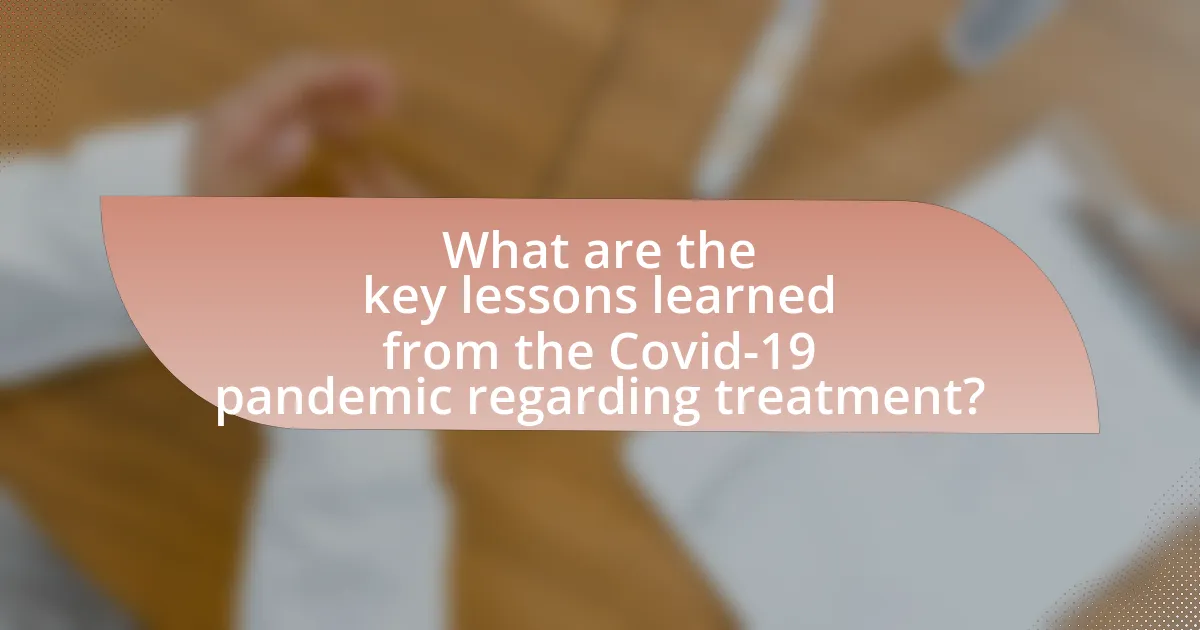The article titled “The Future of Covid-19 Treatment: Lessons Learned from the Pandemic” examines critical insights gained from the Covid-19 pandemic regarding treatment strategies. It highlights the rapid development of vaccines, the evolution of antiviral therapies, and the importance of global data sharing in enhancing treatment effectiveness. Key topics include the initial treatment methods employed, the role of research and innovation, the impact of vaccine development on treatment strategies, and emerging trends in post-pandemic care. Additionally, the article discusses the significance of public health infrastructure, equitable access to treatments, and the implications of long Covid for future healthcare approaches.

What are the key lessons learned from the Covid-19 pandemic regarding treatment?
The key lessons learned from the Covid-19 pandemic regarding treatment include the importance of rapid vaccine development, the need for effective antiviral therapies, and the significance of timely data sharing among global health organizations. Rapid vaccine development was exemplified by the unprecedented speed of mRNA vaccines, which were developed and authorized for emergency use within a year, demonstrating the potential for accelerated research and regulatory processes. Effective antiviral therapies, such as remdesivir and monoclonal antibodies, highlighted the necessity for ongoing research into treatment options for viral infections. Timely data sharing, as seen with the global collaboration through platforms like GISAID, emphasized the critical role of transparency and cooperation in managing public health crises. These lessons underscore the need for preparedness and adaptability in future health emergencies.
How did the pandemic shape our understanding of Covid-19 treatment?
The pandemic significantly advanced our understanding of Covid-19 treatment by accelerating research and development of therapies and vaccines. For instance, the urgent need for effective treatments led to the rapid deployment of clinical trials, resulting in the emergency use authorization of antiviral medications like remdesivir and monoclonal antibodies. Additionally, the global collaboration among scientists and healthcare professionals facilitated the sharing of data, which improved treatment protocols and patient outcomes. This collective effort highlighted the importance of real-time data analysis and adaptive treatment strategies, ultimately shaping a more robust framework for managing Covid-19 and future pandemics.
What treatment methods were initially used during the pandemic?
Initially, treatment methods used during the pandemic included supportive care, antiviral medications, and corticosteroids. Supportive care focused on managing symptoms and providing oxygen therapy for patients with severe respiratory distress. Antiviral medications, such as remdesivir, were administered to reduce viral replication, while corticosteroids like dexamethasone were utilized to mitigate inflammation and improve outcomes in patients requiring oxygen or mechanical ventilation. These approaches were based on early clinical observations and studies that indicated their potential effectiveness in managing COVID-19 symptoms and complications.
How did the effectiveness of these methods evolve over time?
The effectiveness of Covid-19 treatment methods evolved significantly over time, transitioning from initial reliance on supportive care to the development and deployment of targeted antiviral therapies and vaccines. Early in the pandemic, treatments were largely experimental, with healthcare providers focusing on symptom management and supportive care, which had limited efficacy. As research progressed, antiviral medications like remdesivir were authorized for emergency use, demonstrating improved outcomes in hospitalized patients. Furthermore, the rapid development of vaccines, such as those from Pfizer-BioNTech and Moderna, showcased a remarkable leap in treatment effectiveness, leading to a substantial reduction in severe cases and hospitalizations. By mid-2021, real-world data indicated that vaccinated populations experienced significantly lower rates of infection and severe disease, underscoring the evolution of treatment methods from basic care to advanced, evidence-based interventions.
What role did research and innovation play in Covid-19 treatment?
Research and innovation were critical in the development of effective Covid-19 treatments, leading to the rapid creation of vaccines and therapeutic options. The unprecedented speed of vaccine development, exemplified by the Pfizer-BioNTech and Moderna mRNA vaccines, was made possible through years of prior research on mRNA technology, which allowed for a swift response to the pandemic. Clinical trials for these vaccines were conducted in record time, with Pfizer-BioNTech’s vaccine receiving Emergency Use Authorization in December 2020 after demonstrating 95% efficacy in preventing Covid-19 in large-scale trials involving over 43,000 participants. Additionally, research into antiviral treatments, such as remdesivir, provided early therapeutic options that helped manage severe cases of Covid-19. The collaboration between governments, pharmaceutical companies, and research institutions facilitated the sharing of data and resources, accelerating the pace of innovation and ultimately saving millions of lives.
How did vaccine development impact treatment strategies?
Vaccine development significantly shifted treatment strategies by prioritizing prevention over reactive care. The rapid creation of COVID-19 vaccines, such as those by Pfizer-BioNTech and Moderna, demonstrated that effective vaccination could reduce hospitalizations and severe cases, leading to a decreased reliance on intensive treatment methods. For instance, studies indicated that vaccinated individuals had a 90% lower risk of hospitalization compared to unvaccinated individuals, which directly influenced healthcare protocols to focus on vaccination campaigns as a primary strategy for managing the pandemic. This shift has prompted healthcare systems to allocate resources towards vaccination efforts, thereby altering the landscape of treatment strategies to emphasize preventive measures rather than solely therapeutic interventions.
What new therapies emerged as a result of the pandemic?
New therapies that emerged as a result of the pandemic include monoclonal antibodies, antiviral medications like remdesivir, and the use of corticosteroids such as dexamethasone. Monoclonal antibodies, developed to target the SARS-CoV-2 virus, have shown efficacy in reducing hospitalization rates. Antiviral medications like remdesivir were repurposed and demonstrated effectiveness in shortening recovery time for COVID-19 patients. Dexamethasone, a corticosteroid, was found to reduce mortality in severe cases by dampening the inflammatory response. These therapies were validated through clinical trials and real-world studies, significantly impacting treatment protocols for COVID-19.

How can we improve future Covid-19 treatment based on past experiences?
To improve future Covid-19 treatment based on past experiences, healthcare systems should prioritize the development of rapid testing and effective antiviral therapies. The swift identification of Covid-19 cases through rapid testing has proven essential in controlling outbreaks, as seen in countries that implemented widespread testing early in the pandemic, leading to lower transmission rates. Additionally, the success of antiviral treatments, such as remdesivir, highlights the need for ongoing research and investment in therapeutic options that can be deployed quickly during future outbreaks. Historical data from the pandemic indicates that timely access to effective treatments significantly reduces hospitalization rates and mortality, underscoring the importance of preparedness in healthcare infrastructure.
What strategies can enhance the speed of treatment development?
Accelerating treatment development can be achieved through strategies such as leveraging adaptive trial designs, utilizing real-world evidence, and fostering public-private partnerships. Adaptive trial designs allow for modifications based on interim results, which can significantly reduce the time needed to determine efficacy and safety. For instance, the RECOVERY trial for COVID-19 treatments demonstrated how adaptive designs can expedite the identification of effective therapies. Utilizing real-world evidence, such as data from electronic health records, can also speed up the understanding of treatment impacts in diverse populations, as seen during the pandemic. Furthermore, public-private partnerships, exemplified by collaborations between governments and pharmaceutical companies, can enhance resource sharing and streamline regulatory processes, leading to faster development timelines.
How can collaboration between countries improve treatment outcomes?
Collaboration between countries can significantly improve treatment outcomes by facilitating the sharing of research, resources, and best practices. For instance, during the COVID-19 pandemic, countries that collaborated on vaccine development, such as through the COVAX initiative, accelerated the availability of effective vaccines, leading to quicker immunization rates globally. This collaborative effort resulted in over 13 billion vaccine doses administered worldwide by the end of 2022, showcasing the impact of shared knowledge and resources on public health outcomes. Additionally, joint clinical trials and data sharing among nations can enhance the understanding of treatment efficacy and safety, ultimately leading to better patient care and reduced mortality rates.
What role does public health infrastructure play in treatment readiness?
Public health infrastructure is crucial for treatment readiness as it ensures the availability of resources, systems, and protocols necessary for effective healthcare delivery. A robust public health infrastructure facilitates timely access to medical supplies, trained personnel, and information dissemination, which are essential for managing health crises like the COVID-19 pandemic. For instance, during the pandemic, countries with strong public health systems were able to implement widespread testing, contact tracing, and vaccination campaigns more efficiently, leading to better health outcomes. This demonstrates that investment in public health infrastructure directly correlates with improved treatment readiness and response capabilities in emergencies.
How can we ensure equitable access to Covid-19 treatments in the future?
To ensure equitable access to Covid-19 treatments in the future, it is essential to implement policies that prioritize affordability and distribution equity. Governments and health organizations must collaborate to establish frameworks that facilitate the production and distribution of treatments at low costs, ensuring that all populations, especially marginalized communities, receive timely access. For instance, during the pandemic, the COVAX initiative aimed to provide equitable access to vaccines, highlighting the importance of global cooperation in health crises. Additionally, data from the World Health Organization indicates that equitable access can be achieved through transparent pricing models and support for local manufacturing capabilities in low-income countries.
What barriers exist to accessing Covid-19 treatments globally?
Barriers to accessing Covid-19 treatments globally include supply chain disruptions, high costs, and inequitable distribution. Supply chain disruptions have hindered the timely delivery of treatments, particularly in low- and middle-income countries, where healthcare infrastructure may be less robust. High costs of treatments, especially novel antiviral drugs and monoclonal antibodies, limit access for many individuals and healthcare systems. Additionally, inequitable distribution exacerbates disparities, as wealthier nations often secure larger quantities of treatments, leaving poorer countries with insufficient supplies. According to the World Health Organization, these factors collectively impede the global response to the pandemic and highlight the need for more equitable healthcare solutions.
How can policy changes facilitate better access to treatments?
Policy changes can facilitate better access to treatments by streamlining regulatory processes and increasing funding for healthcare initiatives. For instance, the Emergency Use Authorization (EUA) implemented during the COVID-19 pandemic allowed for faster approval of vaccines and treatments, significantly reducing the time from development to public availability. Additionally, policies that expand insurance coverage for telehealth services have improved access to consultations and prescriptions, particularly for underserved populations. According to a study by the Kaiser Family Foundation, states that expanded Medicaid saw a 20% increase in access to necessary treatments, demonstrating the impact of policy on healthcare accessibility.

What are the emerging trends in Covid-19 treatment post-pandemic?
Emerging trends in Covid-19 treatment post-pandemic include the increased use of antiviral therapies, personalized medicine, and long-term management strategies for post-acute sequelae of SARS-CoV-2 infection (PASC). Antiviral treatments, such as Paxlovid and molnupiravir, have gained prominence for their effectiveness in reducing severe outcomes when administered early. Personalized medicine approaches are being developed to tailor treatments based on individual genetic and health profiles, enhancing efficacy and minimizing side effects. Additionally, healthcare systems are focusing on comprehensive care for long COVID patients, integrating multidisciplinary teams to address the complex symptoms and improve quality of life. These trends reflect a shift towards more targeted and holistic treatment paradigms in response to the lessons learned during the pandemic.
How is telemedicine influencing Covid-19 treatment approaches?
Telemedicine is significantly influencing Covid-19 treatment approaches by enabling remote consultations and monitoring, which reduces the risk of virus transmission. This shift allows healthcare providers to assess and manage patients’ symptoms without requiring in-person visits, thereby conserving healthcare resources and minimizing exposure for both patients and medical staff. According to a study published in the Journal of Medical Internet Research, telemedicine usage surged by over 50% during the pandemic, demonstrating its effectiveness in maintaining continuity of care while adhering to social distancing guidelines.
What are the benefits of remote patient monitoring for Covid-19?
Remote patient monitoring for Covid-19 enhances patient care by enabling continuous health tracking and timely interventions. This approach allows healthcare providers to monitor vital signs, symptoms, and overall health status remotely, reducing the need for in-person visits and minimizing the risk of virus transmission. Studies have shown that remote monitoring can lead to earlier detection of complications, improved patient outcomes, and increased patient engagement in their own care. For instance, a study published in the Journal of Medical Internet Research found that remote monitoring significantly reduced hospital readmission rates among Covid-19 patients.
How can technology improve patient engagement in treatment?
Technology can improve patient engagement in treatment by facilitating real-time communication and personalized care. Digital health tools, such as telemedicine platforms and mobile health applications, enable patients to interact with healthcare providers conveniently, leading to increased adherence to treatment plans. A study published in the Journal of Medical Internet Research found that patients using telehealth services reported higher satisfaction and engagement levels, with 70% of participants stating they felt more involved in their care decisions. Additionally, wearable devices that track health metrics empower patients to monitor their conditions actively, fostering a sense of ownership over their health. This combination of communication and self-monitoring enhances patient engagement significantly.
What are the implications of long Covid for future treatment strategies?
Long Covid significantly impacts future treatment strategies by necessitating a more comprehensive approach to post-viral syndromes. Research indicates that approximately 10-30% of individuals who recover from acute Covid-19 experience long-term symptoms, which can include fatigue, cognitive dysfunction, and respiratory issues. This prevalence underscores the need for healthcare systems to develop targeted interventions that address both the physical and psychological aspects of long Covid.
Moreover, studies, such as those published in the Journal of the American Medical Association, highlight the importance of multidisciplinary care models that incorporate specialists from various fields, including pulmonology, neurology, and mental health, to effectively manage the diverse symptoms associated with long Covid. This shift towards integrated care will likely inform the design of future treatment protocols, emphasizing personalized medicine and ongoing patient support.
How does long Covid affect the approach to treatment?
Long Covid necessitates a multifaceted approach to treatment that addresses a wide range of persistent symptoms and complications. This condition can manifest in various ways, including fatigue, cognitive dysfunction, and respiratory issues, which require tailored therapeutic strategies rather than a one-size-fits-all solution. Research indicates that approximately 10-30% of individuals who recover from acute Covid-19 experience long-term symptoms, highlighting the need for specialized care pathways that incorporate multidisciplinary teams, including primary care physicians, specialists, and mental health professionals. This comprehensive approach aims to improve patient outcomes by addressing both physical and psychological aspects of recovery, as evidenced by studies showing that integrated care models can enhance quality of life for long Covid patients.
What research is being conducted to address long Covid symptoms?
Research is being conducted to address long Covid symptoms through various clinical trials and studies aimed at understanding and mitigating the long-term effects of the virus. For instance, the National Institutes of Health (NIH) launched the RECOVER initiative, which involves a multi-site study to investigate the prevalence, causes, and treatment options for long Covid. This initiative includes thousands of participants and aims to collect data on symptoms, biological markers, and potential therapeutic interventions. Additionally, studies published in journals such as “Nature” and “The Lancet” have explored the efficacy of rehabilitation programs and pharmacological treatments for managing symptoms like fatigue, cognitive dysfunction, and respiratory issues. These research efforts are crucial for developing effective strategies to support individuals suffering from long Covid.
What best practices can be adopted for future pandemics?
To effectively prepare for future pandemics, best practices include enhancing global surveillance systems, ensuring rapid vaccine development, and improving public health communication. Enhanced global surveillance systems, such as the Global Health Security Agenda, allow for early detection of outbreaks, which is crucial for timely responses. Rapid vaccine development can be achieved through platforms like mRNA technology, which was pivotal in the swift creation of COVID-19 vaccines. Furthermore, improving public health communication, as demonstrated by the World Health Organization during the COVID-19 pandemic, ensures that accurate information reaches the public, reducing misinformation and panic. These practices are supported by evidence from the COVID-19 response, which highlighted the importance of preparedness and adaptability in managing health crises.
How can lessons from Covid-19 inform treatment protocols for future outbreaks?
Lessons from Covid-19 can inform treatment protocols for future outbreaks by emphasizing the importance of rapid response, data-driven decision-making, and the integration of telemedicine. The Covid-19 pandemic highlighted the necessity for healthcare systems to quickly adapt treatment protocols based on emerging evidence, as seen with the swift adoption of antiviral therapies and monoclonal antibodies. Additionally, the use of real-time data analytics during Covid-19 allowed for better tracking of infection rates and treatment efficacy, which can be applied to future outbreaks to optimize resource allocation and patient care. Telemedicine emerged as a crucial tool for maintaining patient access to care while minimizing virus transmission, demonstrating its value in future health crises.
What role does public education play in treatment effectiveness during pandemics?
Public education significantly enhances treatment effectiveness during pandemics by ensuring that the population is informed about health guidelines, preventive measures, and available treatments. For instance, during the COVID-19 pandemic, effective public education campaigns led to increased awareness of vaccination benefits, resulting in higher vaccination rates, which are crucial for controlling virus spread and reducing severe cases. Research published in the journal “Health Affairs” by Gollust et al. (2020) highlights that clear communication from health authorities can improve public compliance with health recommendations, thereby directly impacting treatment outcomes and overall public health.


